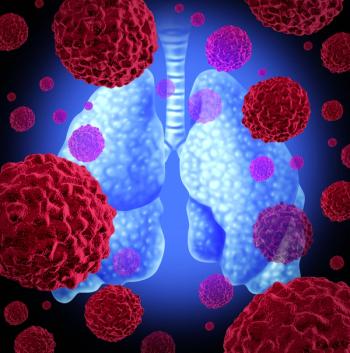
Cabozantinib Improves Outcomes Over Erlotinib in Advanced NSCLC
Cabozantinib alone or in combination with erlotinib improved survival outcomes among patients with advanced EGFR wild-type non–small-cell lung cancer.
Cabozantinib alone or in combination with erlotinib improved survival outcomes among patients with advanced EGFR wild-type non–small-cell lung cancer (NSCLC), according to a new phase II study.
“Erlotinib, an EGFR inhibitor, is highly active in the treatment of tumors harboring EGFR mutations,” wrote study authors led by Joel W. Neal, MD, of the Stanford Cancer Institute in California. “However, more than 75% of NSCLC adenocarcinomas are wild-type for EGFR and do not have another targetable genomic alteration for which drugs are currently available.”
Cabozantinib is an oral tyrosine kinase inhibitor with activity against MET, VEGFR2, RET, ROS1, and other targets. The new study was an open-label, randomized, three-arm, phase II trial that included a total of 125 patients (111 included in primary analysis) with EGFR wild-type NSCLC who had received at least one prior line of therapy. A total of 38 patients in the primary analysis cohort received erlotinib alone, 38 received cabozantinib alone, and 35 received the two drugs in combination. The results were
Progression-free survival with erlotinib alone was 1.8 months, which was significantly shorter than with cabozantinib alone (4.3 months; hazard ratio [HR], 0.39; 95% CI, 0.27–0.55; P = .0003), or with the combination regimen (4.7 months; HR, 0.37; 95% CI, 0.25–0.53; P = .0003). Adjustment for several baseline variables and prognostic factors did not change the results.
Overall survival was also improved with cabozantinib. The cabozantinib monotherapy group had a median overall survival of 9.2 months, compared with 5.1 months with erlotinib (HR, 0.68; 95% CI, 0.49–0.95; P = .071). The combination group had a median overall survival of 13.3 months (HR, 0.51; 95% CI, 0.35–0.74; P = .011). Objective response rates were similar across the groups.
The most common grade 3/4 adverse events included diarrhea, in 28% of patients in the combination group compared with 8% of each of the monotherapy groups; hypertension, occurring in 25% of the cabozantinib group vs none in the erlotinib group and in 3% of the combination group; and fatigue, occurring in similar amounts across the three groups (13%, 15%, and 15%, respectively). Three erlotinib patients discontinued therapy due to adverse events, compared with 11 in the cabozantinib group and 13 in the erlotinib/cabozantinib group. There was one death deemed possibly related to therapy in the cabozantinib group (respiratory failure), and one in the combination group (drug pneumonitis).
In an accompanying
The new study’s authors plan to follow up with a study of cabozantinib involving a non-erlotinib control group, to “further delineate a role for cabozantinib in the treatment of advanced non-squamous NSCLC.”
Newsletter
Stay up to date on recent advances in the multidisciplinary approach to cancer.
































































































